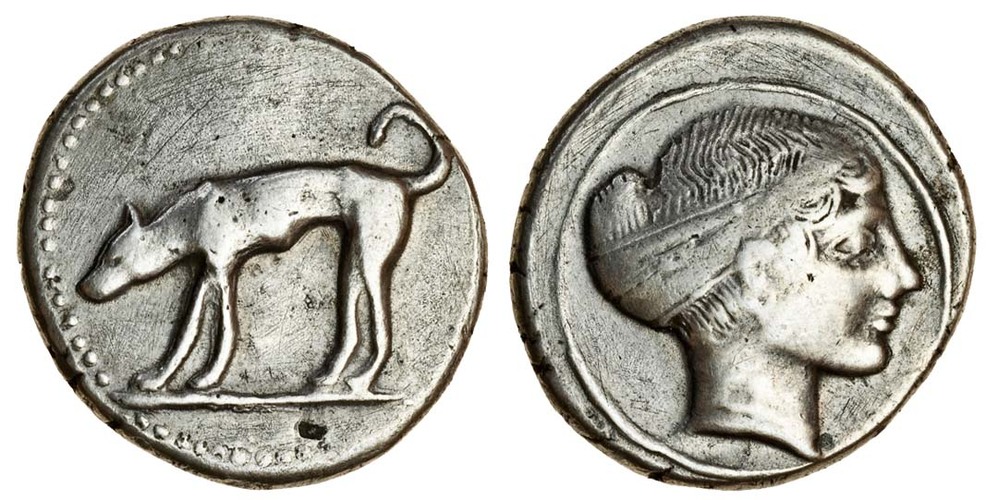Segesta, silver, didrachms (440-416 BCE): Difference between revisions
From SILVER
No edit summary |
m (Callatay moved page S 722 - Segesta, silver, didrachms (440-416 BCE) to Segesta, silver, didrachms (440-416 BCE)) |
(No difference)
| |
Latest revision as of 21:00, 25 July 2023
440 BCE - 416 BCE Silver 2,479 kg
Description
| ObverseInscription or printing placed on the obverse.: | (Hound standing left). |
| ReverseInscription or printing placed on the reverse.: | (ΣΕΓΕΣΤΑZIB) (Greek and Elymaic).Head of the nymph Segesta right, her hair tied at back under broad band |
Mint and issuing power
| MintIdentifies the place of manufacture or issue of a numismatic object.: | Segesta | Ancient regionAncient region.: | Sicily | Modern countryModern country: Italy | AuthorityIdentifies the issuing power. The authority can be "pretended" when the name or the portrait of X is on the coin but he/she was not the issuing power. It can also be "uncertain" when there is no mention of X on the coin but he/she was the issuing power according to the historical sources: |
Chronology
| FromIdentifies the initial date in a range assigned in a numismatic context. | 440 BCE | toIdentifies the final date in a range assigned in a numismatic context.. | 416 BCE | PeriodTime period of the numismatic object.: Classical 480-323 BC |
Physical description
| MetalThe physical material (usually metal) from which an object is made.: | Silver |
Median weightMedian of the weights of numismatic objects (in grams). in grams | 8.50 | DenominationTerm indicating the value of a numismatic object. Examples: tetradrachm, chalkous, denarius.: | didrachm |
StandardStandard.: |
Image

S 722 - Segesta, silver, didrachm, 440-416 BC.jpg [1]
References
| Die study referencePublication of the study: | Hurter 20081Hurter 2008, n° 97-148, pl. 9-12. | ||
| Coin series referenceReference to coin series study: | HGC 22HGC 2, n° 1129 | ||
| Coin series web referenceCoin series web references: | |||
Obverse dies distribution
| FrequencyFrequency of specimen in distribution. ᵖ | Number of obversesNumber of obverse dies. ᵖ (o) | % (o) | Number of coinsNumber of coins. (n) | % (n) | Die nameName(s) of the die(s). |
| 1 | 1 | 6.67 | 1 | 0.32 | 37 |
| 5 | 1 | 6.67 | 5 | 1.58 | 32 |
| 7 | 1 | 6.67 | 7 | 2.22 | 38 |
| 8 | 1 | 6.67 | 8 | 2.53 | 40 |
| 18 | 2 | 13.33 | 36 | 11.39 | 30;34 |
| 19 | 1 | 6.67 | 19 | 6.01 | 43 |
| 20 | 1 | 6.67 | 20 | 6.33 | 44 |
| 21 | 1 | 6.67 | 21 | 6.65 | 31 |
| 22 | 1 | 6.67 | 22 | 6.96 | 42 |
| 23 | 1 | 6.67 | 23 | 7.28 | 35 |
| 34 | 1 | 6.67 | 34 | 10.76 | 33 |
| 38 | 1 | 6.67 | 38 | 12.03 | 39 |
| 40 | 1 | 6.67 | 40 | 12.66 | 41 |
| 42 | 1 | 6.67 | 42 | 13.29 | 36 |
| Total | 15 of 15 | 100.04 | 316 of 316 | 100.01 |
Reverse dies distribution
no distribution is available
Quantification
| Number of obversesNumber of obverse dies. ᵖ (o) | 15 | Number of singletons (o1)The number of singleton coins. ᵖ | 1 |
| Number of reverse diesNumber of reverse dies. (r) | 33 | Number of coinsNumber of coins. (n) | 316 |
| Coins per obverse dieNumber of coins per obverse die. (n/o) | 21.07 | Coins per reverse dieNumber of coins per reverse die. (n/r) | 9.58 |
| Reverse per obverse ratioRatio of obverse dies divided by reverse dies. (r/o) | 2.2 | Percentage of singletons (o1)number of coins (n) divided by the number of singletons (o1) ᵖ | 6.67 % |
| Original number of dies (O) (Carter 1983 formula)The estimation of the number of coins according to Carter 1983 ᵖ | 14.58 | Coins struck if 20,000 as average productivity per dieCoins made if the average productivity for obverses (according to Carter) is 20,000. ᵖ | 291,600 |
| Original number of dies (O) (Esty 2011 formula)The estimation of the number of coins according to the singleton formula in Esty 2011 ᵖ (O) | 15.75 | Survival rate if 20,000 as average productivity per dieSurvival rate if average productivity is 20,000. ᵖ | 0.00108 |
| Coverage (o = % of O) (Esty 1984 formula)Esty 1984 - coverage (% of O) ᵖ (o = % of O) | 99.68% | Die productivity if survival rate 1/2,000Average productivity if survival rate is 1/2,000. ᵖ | 43,347.05 |
| Weight of silver (in kg) if 20,000 coins per die (O = Carter formula)Carter 1983 * Median weight * 20000 (*10 if gold or electrum) ᵖ | 2,479 kg <br /> 2,479 kg | Die productivity if survival rate 1/5,000Average productivity if survival rate is 1/5,000. ᵖ | 108,367.63 |
Remarks
Most likely more than 2 workstations